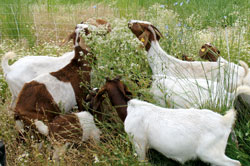Promoters of multi-species grazing love to discuss the environmental benefits of managing vegetation for increased forage production, reduced fire fuel loads, better wildlife habitat and noxious weed control. However, some ranchers are now making money by offering their livestock grazing services.

Bonnie and Stan Jensen rent goats to graze persistent weeds in Idaho.– Photo by Ron Daines
While herbicides are an effective front-line weapon in the war on weeds in most areas, weed warriors decline to use them or hold back where the agri-chemicals might contaminate water or are too expensive to apply. In Idaho, in areas where herbicides are not traditionally used yet, noxious weeds are spreading rapidly. Cashmere goat producer Bonnie Jensen charges $1 a day per goat to graze spotted knapweed and leafy spurge, typically providing herd sizes of 250 goats.
During Jensen’s SARE-funded pilot project, the goats ate all of the knapweed buds and blooms on the Salmon City Water Works, the town’s water source where herbicides are banned, in four days. Fewer than 5 percent of the plants bloomed again that year. Then the goats moved on to a 40-acre Bureau of Land Management test area and ate 90 percent of the leafy spurge. The spurge grew again that year, but did not flower.
Jensen employs a herder on horseback with two dogs. The herder moves the goats to the weeds so they consume a higher percentage of weeds instead of eating grass and shrubs.
“Most noxious weeds are not the problem, they’re a symptom of how the land has been managed,” says Don Nelson, project director for another SARE-funded multi-species grazing education project in Washington. “Cattle like to graze grass, but sheep also prefer forbs and goats prefer woody browse. If you know these preferences, you can inventory a site and create a future landscape using them as tools.”
After Nelson introduced 30 grazing professionals to multi-species grazing techniques, one participant teamed up with a local rancher to clear 600 acres of knapweed and potential fuel for wildfires using sheep and goats. Another participant helped a ranch manager use goats to control young Russian olive trees – thorny sprouters that are hard to control with herbicides and fire. The ranch manager also used goats and cattle to graze bulrushes in standing water. The goats opened up the bulrush patches enough to dry them out, then the rancher grazed cattle there to knock down the rest of the “tules.” Prior to the goat grazing, he never could dry the ground enough to drive a tractor through the bulrushes.

“We wanted to demonstrate a method of managing rangelands that would positively impact the triple bottom line – the environment, the ecosystem and society – by reducing input costs, increasing productivity and enhancing the ecosystem,” Nelson says. “This includes conversion by ruminants of undesirable plants to marketable products and a reduction in herbicides.”
